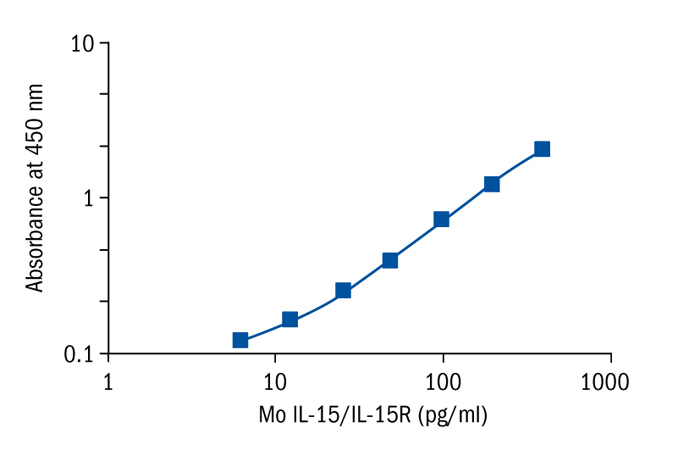Type
Sandwich ELISA, Biotin-labelled antibody
Applications
Serum, Plasma-EDTA, Cell culture supernatant
Sample Requirements
50 ul/well
Shipping
At ambient temperature. Upon receipt, store the product at the temperature recommended below.
Storage/Expiration
Store the complete kit at 2–8°C. Under these conditions, the kit is stable until the expiration date (see label on the box).
Calibration Curve
Calibration Range
6.3–400 pg/ml
Limit of Detection
2.0 pg/ml
Research topic
Cytokines and chemokines and related molecules, Animal studies
Summary
Interleukin-15 (IL-15) is a 14 kDa proinflammatory protein that has been shown to play a role in the activation of neutrophils, dendritic cells, and macrophages, and is essential to the development and survival of NK cells and CD8 T-cells. IL-15 activates Jak/Stat pathways by signaling through a heterotrimeric receptor. Two of the subunits of this receptor, β and γ, are shared with the IL-2 receptor, while the α subunit is unique to IL-15. Despite the expression of IL-15 mRNA in many cell types, the secreted protein is rarely detectable in biological samples. Recent research suggests that IL-15 is retained inside the cell and is only secreted in complex with its unique receptor, IL-15Rα. This chaperoning is required from the ER to Golgi through to secretion. The cytokine/receptor complex may stay bound to the cell surface, where it can be transpresented to cells expressing the βγ subunits of the receptor, or may be secreted in a soluble form that lacks the transmembrane domain of the receptor. The soluble IL-15/IL-15R complex is produced by mouse dendritic cells, fibroblasts, and macrophages, and demonstrates a 10- 100-fold increase in agonistic activity over IL-15 alone.
Instructions for Use (RUO)
Instructions for Use (RUO)
Safety Information (RUO)
MSDS (RUO)
Find documents for the lot

